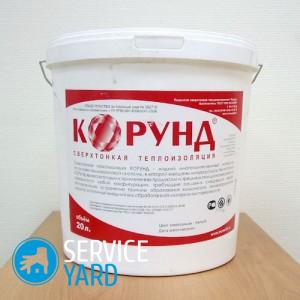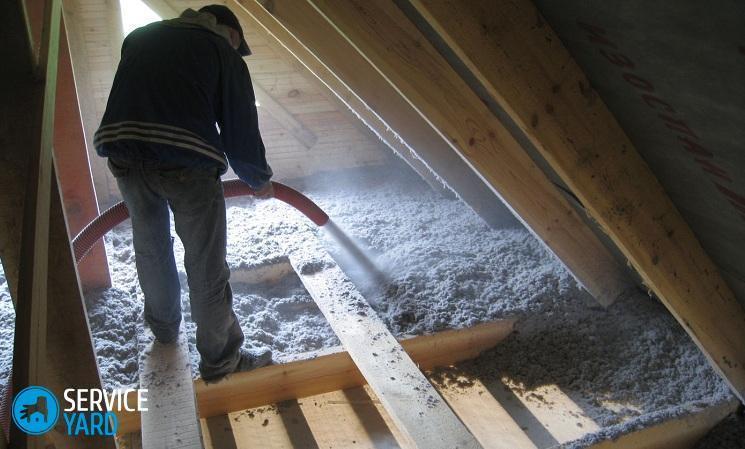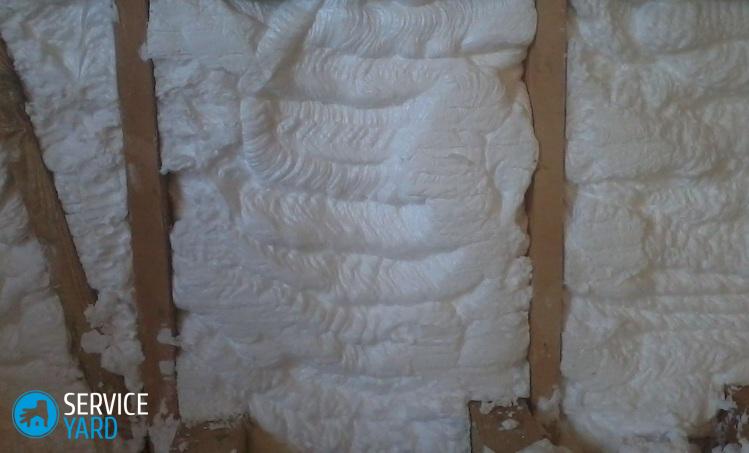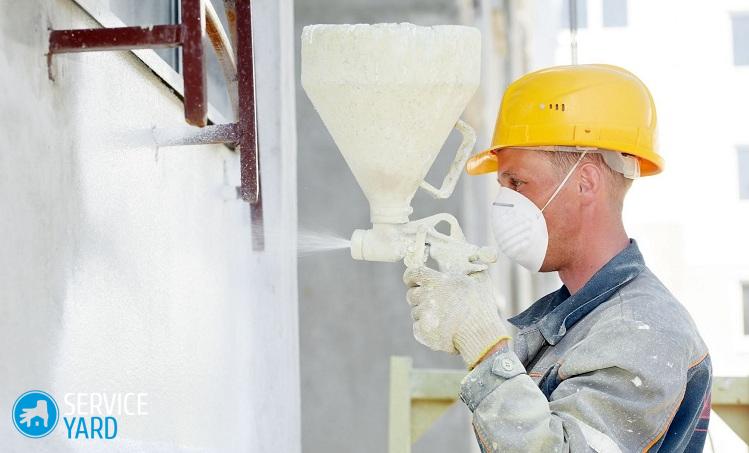Liquid insulation

In the huge variety of all kinds of heat-insulating materials that are presented today in the building materials market, it is not easy to navigate even for a professional builder. What can we say about ordinary people who decided to warm their homes on their own without the involvement of specialists. And the thing is that each of the insulating materials on the market has its own operational features, technical characteristics and scope. One of such modern heat insulators is a liquid insulation for walls.
to contents ↑Types of liquid insulation
Under the name “liquid insulation for walls” mean two completely different groups:
- Paints with a thermal effect, which are intended for painting the internal surfaces of walls, as well as external thermal insulation.
- Foamed heaters are foamed polymers (polystyrene foam, polyurethane foam, penoizol).
Important! In addition to them, there is still a small group of not so long ago developed polymers, which today are still under development and it is not yet possible to buy them from us.
Each of these groups has its own technical properties and operational characteristics, as well as methods of applying them to the treated walls. It is because of the cardinal differences that different liquid insulation for walls should be considered as two separate materials - foam and paint insulation.
to contents ↑Important! Before choosing one or another option, you must carefully familiarize yourself with all the nuances of their application.
Thermal paint
Thermo-paint is a relatively new material that appeared on the construction market no more than ten years ago. It is used as a heater for wall surfaces inside and outside buildings.
Structure
In its appearance, the paint thermal insulation is almost no different from ordinary acrylic paint - it has a similar structure and even smell. But, unlike acrylic, thermal paints are a high-tech product and have a rather complex composition.
In scientific terms, this is not an ordinary paint, but a liquid suspension, which has a heat-preserving effect. It includes the following:
- Small glass ceramic particles that have a spherical shape. Their diameter is 0.05-0.1 mm.
- Spherical micro-accumulators made of aluminum silicates are about the same size as glass-ceramic. The main feature of aluminosilicate spheres is the absence of air in them: the internal vacuum makes them an excellent heat insulator for walls.
- Titanium dioxide - having a porous structure, it has a very small weight. Prevents heat transfer from the warm walls of the house to the cold air from the inside.
- Latex - gives the material resistance to sunlight, compensating for thermal narrowing / expansion. Thus, it prevents peeling and cracking of the painted layer, thereby increasing the service life of liquid thermal insulation. This makes it possible to use the suspension for processing walls outside the houses: basement, facade, as well as pediments of insulated attics, etc.
- Acrylic - plays the role of the basis of the entire heat-insulating mixture - hence the similarity of liquid insulation with the usual acrylic paints. Acrylic gives the composition good adhesion to almost any wall surface.
Specifications
Following the statements of manufacturers, liquid heaters for painting walls have unique thermal insulation properties. Of these, the following can be noted:
- According to technical tests, a 1.1 mm thermal paint layer is able to effectively replace a 50 mm thick mineral wool layer. This excellent indicator is achieved due to the presence inside the thermal layer of many microspheres filled with vacuum. This significantly reduces heat loss from inside the building due to convection. The brilliant color, which is created by glass ceramics, titanium and aluminum derivatives, serves as additional protection, effectively reflecting infrared radiation.
Important! In general, such a paint thermal insulation coating is able to work as a reflective thermos coating.
- The consumption of the heat-insulating suspension is approximately 1 liter per 2 square meters when applied with a thickness of 0.5 mm. Apply it in several layers to obtain a thickness of 1-2 mm.
- Regardless of whether the walls are insulated from the inside or outside, reaching the indicator declared by the manufacturer (1 mm thermal paint = 50 mm with a layer of mineral wool) will not work. According to the instructions for use, it is enough to apply heat-saving paint to the wall surface with a brush or roller, so that it warms up sharply in the interior rooms.
Important! As the practice of using such materials shows, their treatment of the brick walls of the house outside makes it possible to increase the temperature in the rooms in the winter by 1.5-2 degrees. That is, there is an effect, but still it is far from the indicated 1 mm = 50 mm. To get a similar effect, according to simple calculations, you will have to cover the perimeter of the building with 12-15 layers of heat-saving paint. And it will be very expensive, given the high price of such formulations.
Advantages of thermal paints
Despite the controversial issue of the effectiveness of thermal paints, they still have a number of advantages:
- First of all, this is the aesthetic side. As experienced finishers recommend, if you have already decided to paint the walls of your house, then for these purposes it is better to use thermal suspension, of course, if you can afford it.
- On the one hand, you get a wonderful decorative effect, which gives this coating with a beautiful iridescent metallic sheen. On the other hand, the presence of a heat-saving effect, although not large, which conventional paint and varnish compositions do not have.
- Thermal paint has anticorrosive and antiseptic properties, therefore the treatment of such external or internal surfaces of the building, as well as ventilation ducts and communication pipes, will make it possible to avoid mold, fungus and corrosion on them.
- A considerable advantage is the water-repellent properties of the paint, which makes it possible to additionally create a waterproofing layer for the external and internal surfaces of the walls.
- The convenience of using thermal suspensions for the implementation of insulation of communication pipes in hard-to-reach places is undeniable. Ease of application makes this thermal insulation option the most successful.
The right choice of thermal paint
Since heat painting is quite expensive, you should know how to choose the right quality product. To do this, you need to know some nuances:
- The lower the density of the coloring composition, the better its thermal insulation properties. Typically, a 10 liter bucket of suspension has a weight of not more than 6.5 kg. Otherwise, it is highly likely that the expensive mixture was diluted with simple acrylic paint, thereby deteriorating its technical properties.
- When choosing a composition, raise the container and look through it at the light. Lightweight microspheres fillers should rise up, while creating a metallic layer on top. The thicker this layer, the higher the quality of this suspension.
- If, after mixing a good-quality paint, stretch its drop between the fingers, you can feel the presence of many microspheres - the surface will be rough, not smooth.
Application Method
Decorating the walls with liquid insulation is not difficult. The work is carried out in several stages and it is completely similar to the process of painting surfaces with ordinary paint and varnish compositions.
Important! When buying a thermal composition, it is necessary to consider that it will be necessary to process the surface more than once. Depending on the climatic zone of the dwelling, it may be necessary to apply from 2 to 5 layers of the mixture.
The work process step by step is as follows:
- Measure the area of the painted surface and purchase the necessary amount of heat-protective paint.
- Prepare the surface for applying the composition - clean from dirt and dust, putty in the cracks and seams, treat with a primer.
- Before use, mix the paint thoroughly with a mixer nozzle to evenly distribute spherical filler granules throughout the volume.
- Apply thermal paint to the surface using a roller or spray gun. Paint over corners and seams with a paint brush.
- After the first layer has completely dried, apply the second layer, etc.
to contents ↑Important! Until completely dry, that is, at least a day, the painted wall should not fall under heavy rain. He can wash light micro-granules fillers from thermo-paint, because of which expensive thermal insulation will turn into ordinary acrylic paint.
Foamed polymers
Other liquid heat insulators for walls are foamed polymers - liquid polyurethane, polystyrene, etc.
Advantages and disadvantages of foam insulation:
- Unlike solid insulation boards, liquid polymers guarantee an increased level of thermal insulation. The fact is that when laying sheets of the same foam it is very difficult to achieve their tight fit to the surface of the walls. In any case, after some time, a gap will appear between them, which significantly reduces the effectiveness of thermal protection.
- In the process of applying liquid foam to the surface, it adheres tightly to it without any gaps. Due to the high-quality adhesion of the foamed compounds, they adhere perfectly to any surface - brick and wooden walls, concrete floor slabs and metal pipes.
- In addition, for a solid and uniform application of foam, it is not necessary to level, putty or any other preparation of the walls. If the foamed insulation is applied to the facade of the building, then after solidification in the future it can be subjected to decorative processing. To cut off influxes and surpluses of foam, then to process with putty leveling compound.
Important! The service life of such thermal insulation can be approximately 50-70 years.
- Among the disadvantages of such a thermal insulation material, it is worth noting its low environmental friendliness. When heated, polymers begin to release volatile chemicals into the air, and when burned, they emit caustic smoke in large quantities.
- Resistance to flame in foamed insulation is zero. In addition, he himself actively supports combustion, thereby contributing to the spread of fire.
- One more minus - the surfaces processed by such foam cease to pass air through itself. As a result, the natural vapor and gas exchange inside the room is disrupted. To restore it, you will have to install an efficient ventilation system.
Important! The only exception is penoizol, which does not support combustion under normal conditions and is able to serve as fire protection.
Structure
Liquid insulation in the form of foam is made using a number of complex components. They include the following:
- Urea-formaldehyde resin.
- Foaming chemical components.
- Orthophosphoric acid.
- Water.
Important! Due to the fact that toxic substances are used as ingredients, it is necessary to use protective clothing, including glasses, a respirator and gloves, in the process of spraying foam insulation.
Application Method:
- Foamed polymers are applied to workpieces using special devices that are connected either to an air compressor or to compressed air cylinders.
- All chemicals are loaded into the bunker of the mixer, and water is added there.
- After this, the stirrer hatch is sealed. As a result of a chemical reaction inside the foam begins to be produced, which under pressure is fed out through a special nozzle.
When warming the walls of houses, two different technologies can be used:
- Intra-wall insulation. It is used directly during the laying of brick walls. At the same time, inside the masonry leave channels about 1-1.5 m long and half a brick wide. After the walls are raised by 1-1.5 meters, the wells are filled with foamed polymer. Next, the masonry rises to the same height, the process of filling the wells is repeated.
Important! This method is used when the walls of the house are built of facing bricks, and external insulation is not provided for by the project.
- External insulation. It is made by spraying polystyrene foam or another polymer on the external walls of the house. This treatment is carried out immediately before the finish of the house. After drying, the foam forms such a good adhesion to the wall that it serves as a good basis for applying subsequent layers of decorative finish. Such a surface can be puttied, plastered, simply covered with glass magnesium, siding or other finishing material.
Stock footage
After a detailed review of all the features and nuances of both materials of a liquid insulation for walls you can choose in favor of one of them. Everything will depend on the design features of the house, shown to the level of thermal protection, as well as the financial capabilities of the building owner.
- How to choose a vacuum cleaner taking into account the characteristics of the house and coatings?
- What to look for when choosing a water delivery
- How to quickly create comfort at home - tips for housewives
- How to choose the perfect TV - useful tips
- What to look for when choosing blinds
- What should be running shoes?
- What useful things can you buy in a hardware store
- Iphone 11 pro max review
- Than iPhone is better than Android smartphones






